The Uses and Gratifications Theory (UGT), originally proposed by Elihu Katz in the mid-1970s, is a mass communication paradigm that focuses on the psychological needs which drive individuals to seek specific media outlets and content. UGT posits that the audience plays an active role in choosing and using the media. It asserts that the users have the power to decide how they will use the media and how it will affect them. This theory is in opposition to the traditional perspective of passive media consumption, where the media is seen as a powerful entity that can manipulate its audience. Instead, it offers a more user-centric approach, emphasizing audience autonomy, volition, and agency.
Importance of the Uses and Gratifications Theory in Mass Communication
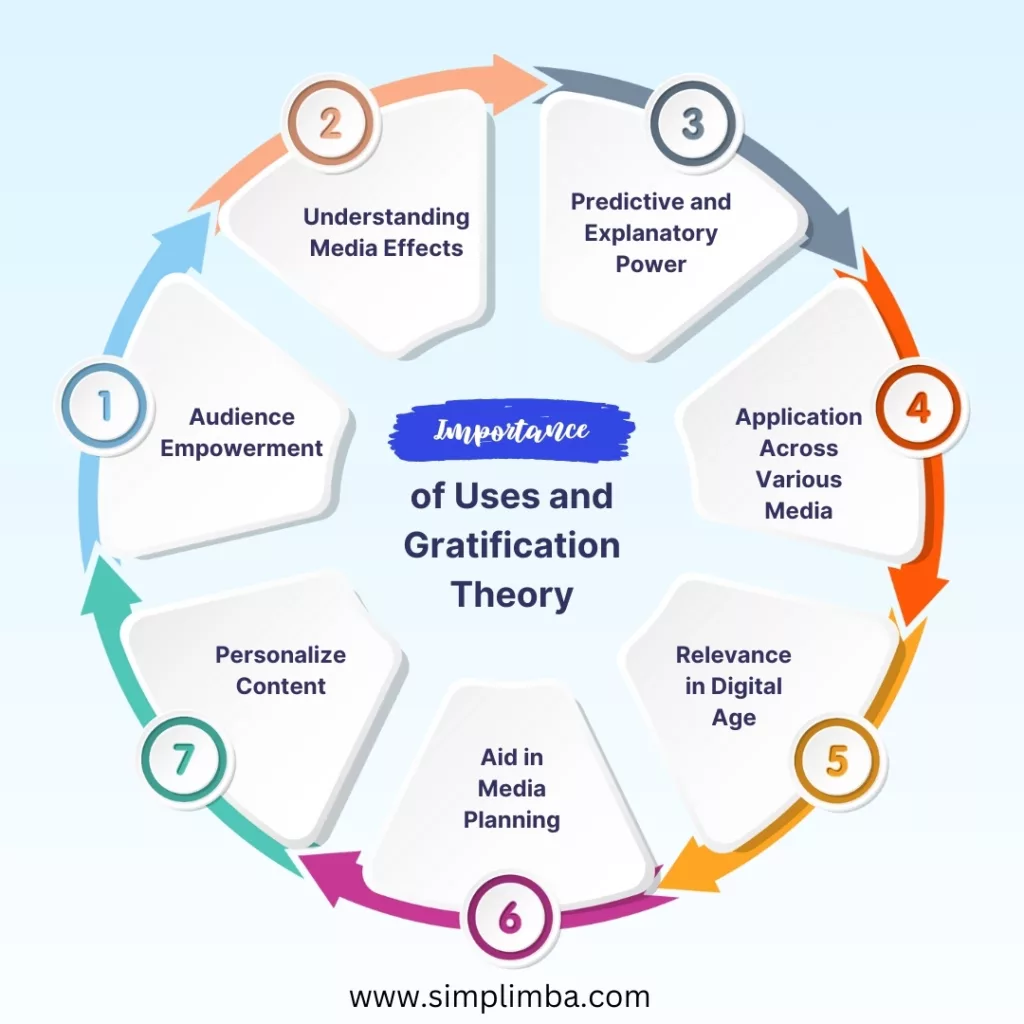
The UGT is particularly significant in mass communication for several reasons:
Audience Empowerment: The theory emphasizes the power of the audience in the media consumption process, highlighting that the control lies with them and not just the media creators. It thus fosters a more balanced view of the media-audience relationship, challenging the notion of audiences as mere passive recipients.
Understanding Media Effects: UGT helps researchers understand why individuals choose certain media over others. By focusing on the needs and gratifications sought by the audience, researchers can better explain media effects and preferences.
Predictive and Explanatory Power: With its focus on psychological needs and gratifications, UGT has strong predictive and explanatory power. It can predict media use based on audience needs and explain why certain media or content are more popular than others.
Application Across Various Media: UGT is applicable across various media forms and content types, ranging from traditional media like newspapers and TV to new media like social media platforms and online games.
Relevance in Digital Age: In today’s digital age, where audience members are not just consumers but also creators of media content, UGT’s importance has further magnified. It helps understand user behavior on digital platforms, including why they share, like, or comment on certain posts and not others.
Aid in Media Planning: For practitioners, understanding the uses and gratifications of their audience can inform media planning and content creation. It helps them tailor their strategies to better meet audience needs and preferences, thereby enhancing audience engagement and satisfaction.
Key Elements of Uses and Gratifications Theory
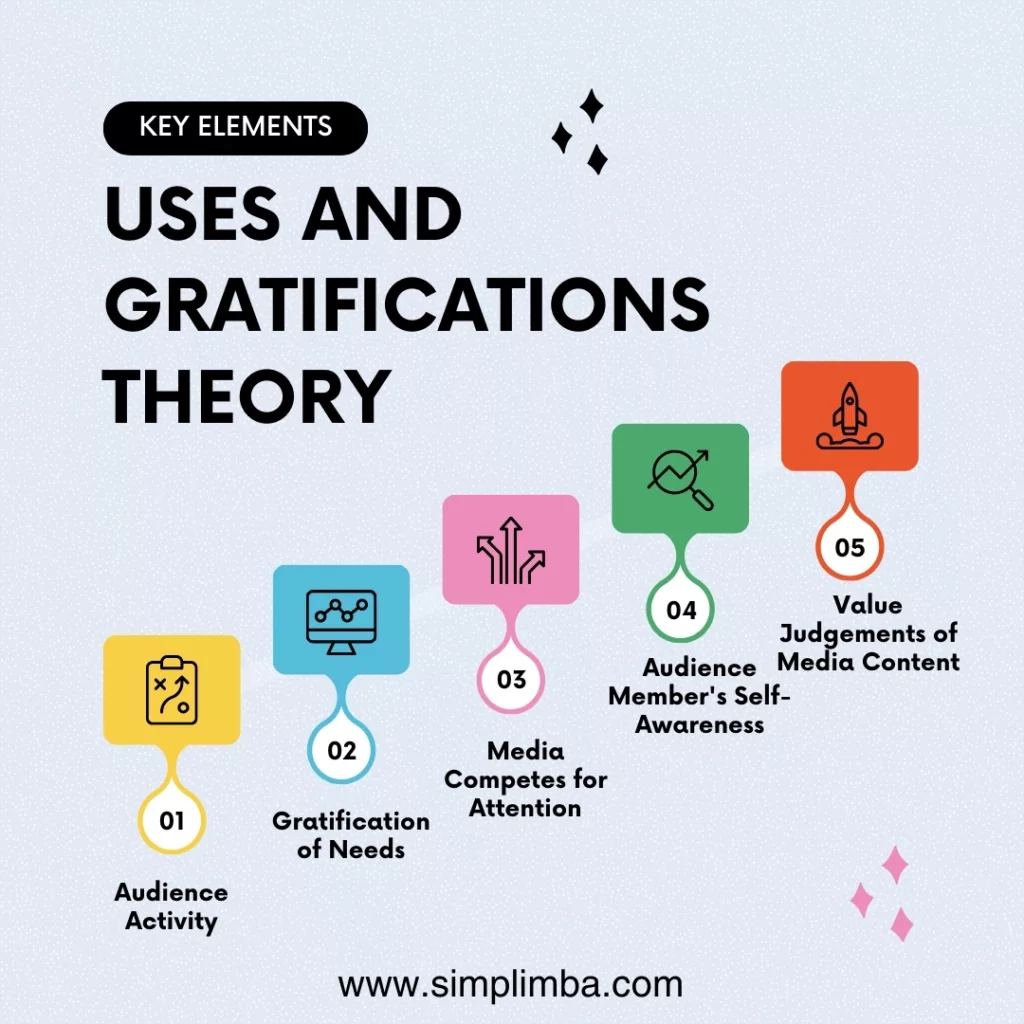
The Uses and Gratifications Theory (UGT) is a popular approach to understanding mass communication. This theory posits that media users play an active role in choosing and using the media. Users take an active part in the communication process and are goal oriented in their media use. The theorists say that a media user seeks out a media source that best fulfills the needs of the user, and that the media competes against other information sources for need satisfaction.
The key elements of the Uses and Gratifications Theory include the following:
Audience Activity: The audience is not a passive recipient of media. Rather, they actively seek out specific media and content to fulfill specific needs or goals, such as entertainment, information, personal identity, or social interaction.
Gratification of Needs: The audience has various needs or desires that they seek to gratify through using media. These needs can range from cognitive needs (acquiring information, knowledge, and understanding), affective needs (emotion, pleasure, feelings), personal integrative needs (credibility, stability, status), social integrative needs (family and friends), and tension release needs (escape and diversion).
Media Competes for Attention: There are numerous forms of media (TV, internet, radio, newspapers, etc.) and each competes for the user’s attention. Users make choices about which media to consume based on which will best satisfy their needs.
Audience Member’s Self-Awareness: The theory assumes that audience members are aware of their needs and can verbalize their motives or reasons for consuming specific media content.
Value Judgements of Media Content: UGT avoids making value judgments about the specific media content, as it’s more interested in the underlying needs and motivations.
5 Real Life Examples of Uses and Gratifications Theory
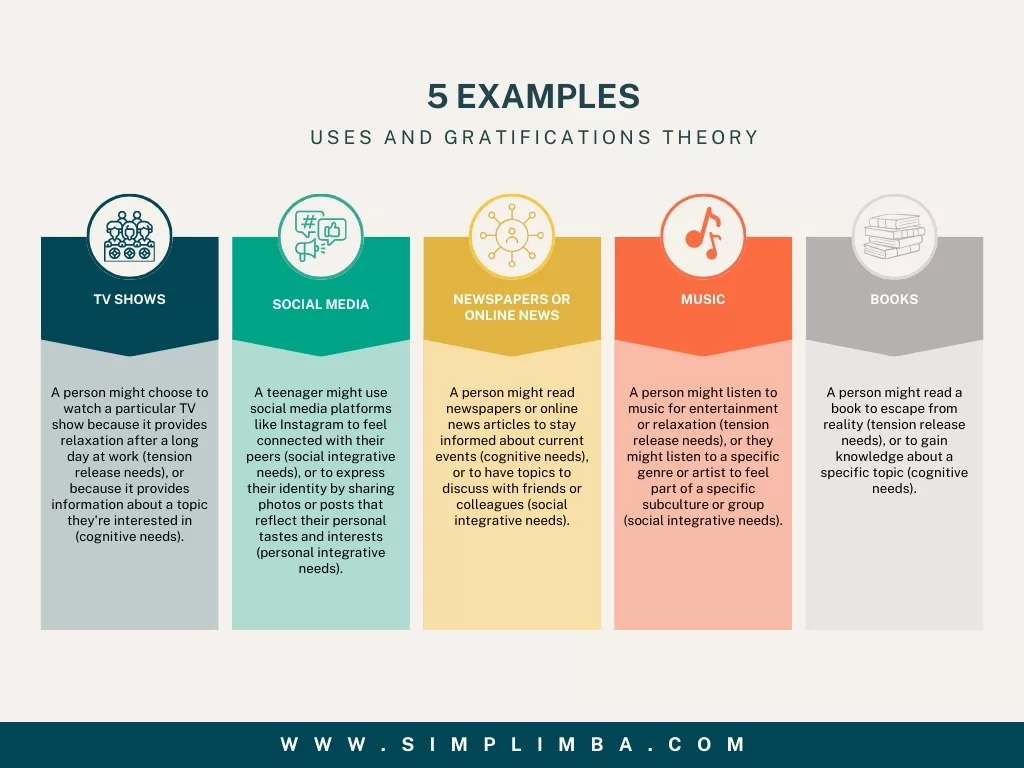
TV Shows: A person might choose to watch a particular TV show because it provides relaxation after a long day at work (tension release needs), or because it provides information about a topic they’re interested in (cognitive needs).
Social Media: A teenager might use social media platforms like Instagram to feel connected with their peers (social integrative needs), or to express their identity by sharing photos or posts that reflect their personal tastes and interests (personal integrative needs).
Newspapers or Online News: A person might read newspapers or online news articles to stay informed about current events (cognitive needs), or to have topics to discuss with friends or colleagues (social integrative needs).
Music: A person might listen to music for entertainment or relaxation (tension release needs), or they might listen to a specific genre or artist to feel part of a specific subculture or group (social integrative needs).
Books: A person might read a book to escape from reality (tension release needs), or to gain knowledge about a specific topic (cognitive needs).
In each of these examples, the individual is making an active choice about which media to consume based on what needs they’re trying to satisfy. The Uses and Gratifications Theory suggests that understanding these underlying needs can help us better understand why people choose to consume specific media content.
Historical Context of Uses and Gratifications Theory
Development and Evolution of Uses and Gratifications Theory
The Use and Gratifications theory originated in the late 1940s when researchers became interested in why people engaged with certain forms of media. Herta Herzog (1944) was one of the pioneers in this field, studying why audiences chose to consume soap operas, quizzes, and advice programs on radio.
This curiosity was further developed in the 1970s by Elihu Katz, Jay G. Blumler, and Michael Gurevitch, who felt that the existing media effects theories inadequately explained audience behavior. They proposed a shift from what media does to people (media effects paradigm) to what people do with media (uses and gratifications paradigm).
Over the next decades, the theory was expanded to include a broader range of media, including television, the internet, and social media. This evolution was marked by a growing interest in the active role of the audience in choosing and using media, highlighting the importance of individual agency and choice.
An essential evolution was the incorporation of the concept of ‘gratification.’ Katz, Blumler, and Gurevitch (1974) identified five categories of gratification: cognitive needs, affective needs, personal integrative needs, social integrative needs, and tension-free needs. This was a significant contribution to the theory as it gave a comprehensive overview of why people use media.
Influence of Uses and Gratifications Theory on Mass Communication Studies
The Uses and Gratifications theory has contributed significantly to the field of mass communication studies. The shift from a media-centric to an audience-centric approach has encouraged researchers to explore more about audience behaviors, needs, and motivations.
The theory has provided a valuable framework for understanding the ‘active audience.’ This has altered how media effects are studied, moving away from the idea of media as a powerful influencer of passive audiences.
It has led to a more nuanced understanding of media consumption. Instead of viewing all audience members as a homogenous group, the theory acknowledges individual differences in media usage. This has implications for media planning, product development, and audience segmentation in mass communication.
The theory has been pivotal in studying the rise of new media, including social media and digital platforms. It has offered valuable insights into why and how people use these platforms, contributing to the development of strategies for online engagement and digital marketing.
Despite some criticism for its limited focus on the content of the media and its lack of consideration for the social and cultural context, Uses and Gratifications theory remains an influential framework in mass communication studies. It provides a foundation for studying the complex dynamics between media producers and consumers, which is increasingly relevant in today’s digital age.
Notable Scholars and Their Contributions
Elihu Katz: Katz is often credited as one of the primary developers of the Uses and Gratifications Theory. His seminal work, “The Uses of Mass Communication: Current Perspectives on Gratifications Research,” laid the foundation for the theory. Katz challenged the notion that the media is merely a manipulative entity and suggested that audiences actively select and interpret media content.
Jay G. Blumler: Together with Katz, Blumler further developed the Uses and Gratifications Theory. His research focused on the social and psychological needs that media consumption can fulfill. Blumler also categorized various media uses into groups, such as diversion, personal relationships, personal identity, and surveillance.
Michael G. Milne: Milne expanded the theory by focusing on the gratifications sought and obtained from different media. He emphasized the role of individual differences in media use and gratification.
Dolf Zillmann: Zillmann focused on the concept of ‘mood management’ in relation to media consumption. He proposed that individuals select media content that aligns with their current mood or helps them alter an undesired mood.
7 Powerful Applications of Uses and Gratifications Theory in Mass Communication
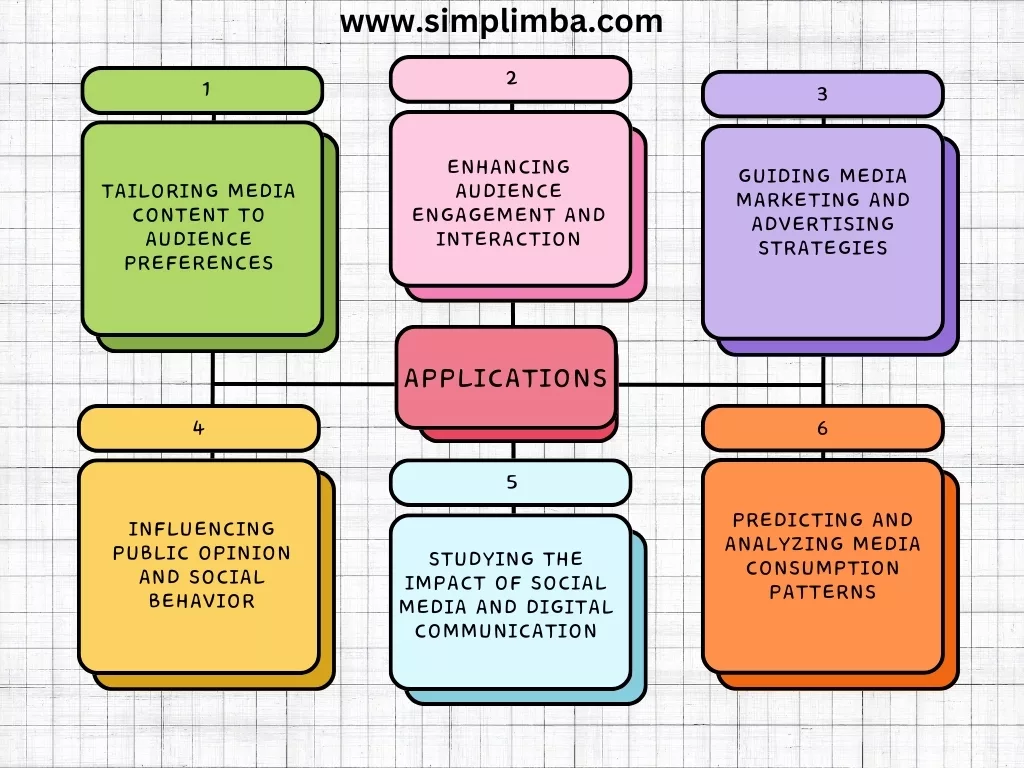
Tailoring Media Content to Audience Preferences
The Uses and Gratifications Theory (UGT) posits that media consumers actively choose specific media content to fulfill particular needs or desires, such as entertainment, information, personal identity, integration and social interaction. Researchers can use UGT to identify the key motivations behind an audience’s media preferences, allowing media providers to tailor their content accordingly. This could involve studying audience demographics, conducting surveys or interviews, and analyzing data on media consumption patterns. For example, a media company might find that its audience prefers short, visually engaging content and adjust their output to meet this preference.
Enhancing Audience Engagement and Interaction
UGT can also aid in increasing audience engagement and interaction. By understanding the gratifications sought by the audience, media providers can create content that stimulates interaction, such as user-generated content, interactive quizzes, and open discussion platforms. This not only increases engagement but also fosters a sense of community among the audience. The analysis of interaction patterns can provide further insights into audience behavior and preferences, which can be used to continually enhance engagement strategies.
Guiding Media Marketing and Advertising Strategies
UGT can guide the development of effective marketing and advertising strategies. By understanding what gratifications consumers seek from media, marketers can create advertisements that resonate with these needs. For example, if consumers use media for personal identity, ads can be designed that appeal to this need by reinforcing or challenging consumers’ self-concepts. This approach can increase the likelihood of the advertisement being noticed and remembered, and hence, the likelihood of the advertised product being purchased.
Influencing Public Opinion and Social Behavior
UGT has implications for the shaping of public opinion and social behavior. By understanding the gratifications people seek from media, it is possible to produce content that influences these areas. For instance, media can be used to promote healthy behaviors or positive social norms if it is known that audiences seek informational or integrative gratifications from media.
Studying the Impact of Social Media and Digital Communication
UGT is particularly relevant in the era of social media and digital communication. Researchers can use the theory to study how these new media forms are used and what gratifications they provide. This can offer insights into how social media and digital communication shape societal trends and individual behavior. For instance, the widespread use of social media for news consumption might reflect a desire for immediate, convenient access to information.
Predicting and Analyzing Media Consumption Patterns
UGT can be used to predict and analyze media consumption patterns. By identifying the gratifications audiences seek from media, it is possible to predict what type of media content they will consume. Additionally, by studying changes in gratifications over time, researchers can analyze shifts in media consumption patterns. For instance, an increased desire for social interaction might predict a rise in the consumption of social media.
Facilitating Effective Crisis Communication
Lastly, UGT can facilitate effective crisis communication. Understanding the gratifications that audiences seek from media during times of crisis can help inform the development of effective communication strategies. For example, during a public health crisis, audiences may seek immediate, accurate information. Media providers can cater to this need by prioritizing the delivery of timely, reliable information.
Critiques and Limitations of the Uses and Gratifications Theory
Main Critiques from Scholars
Lack of Social Context Consideration: The Uses and Gratifications Theory is primarily focused on the individual’s interaction with media, often neglecting the role of societal factors. Scholars such as Katz, Blumler, & Gurevitch argue that the theory lacks a comprehensive understanding of how social and cultural contexts influence media uses and gratifications.
Overemphasis on the Audience’s Activity Level: Critics like Livingstone have noted that the theory tends to overestimate the level of activity and involvement of the audience. This critique posits that not all media consumers are as actively involved in choosing and interpreting media messages as the theory suggests.
Methodological Concerns: Some scholars point out methodological issues with Uses and Gratifications Theory. For instance, Rubin criticized the prevalent use of self-reporting methods, which are prone to biases and inaccuracies.
Predictive Power: The theory is also critiqued for its limited predictive power. As per critics like Palmgreen & Rayburn, it isn’t clear how the identified uses and gratifications can predict future media behavior.
Limitations for Uses and Gratifications Theory3
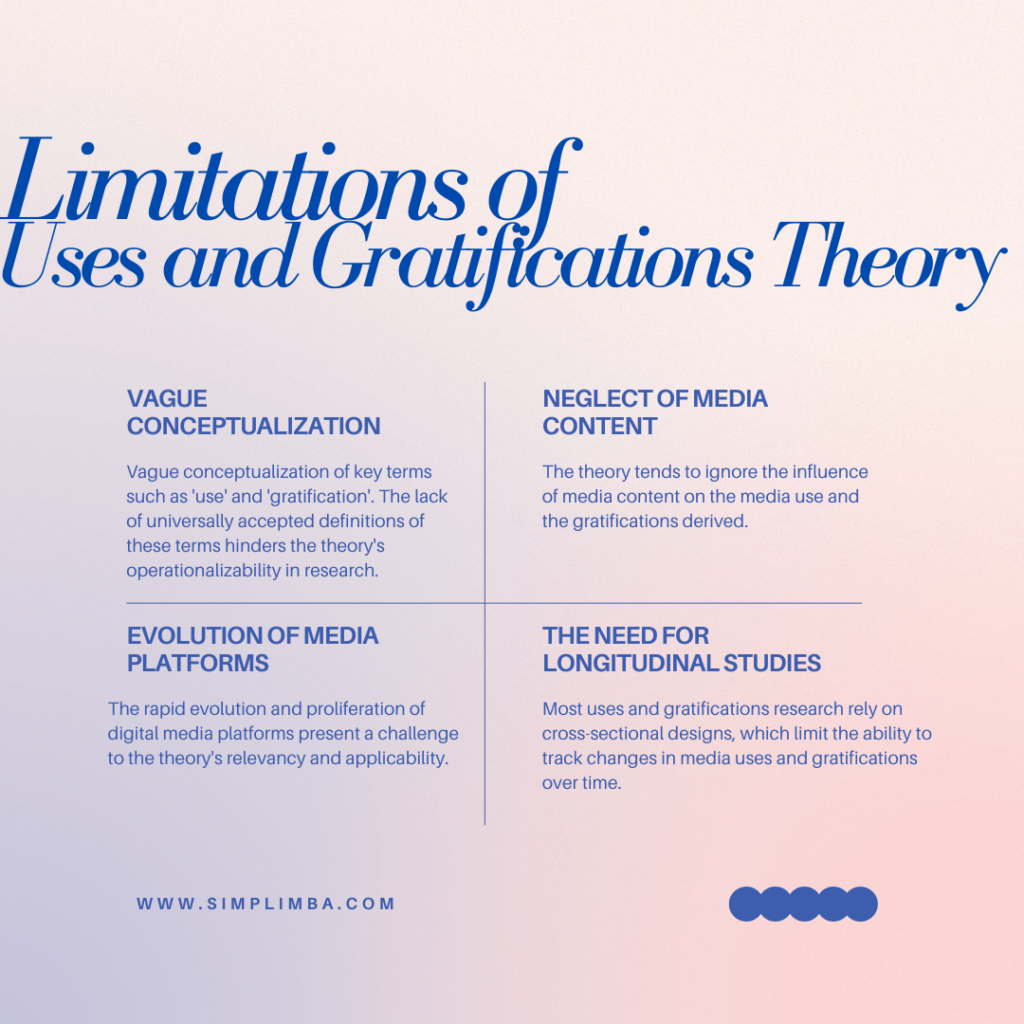
Vague Conceptualization: One of the key limitations noted by scholars like Swanson is the vague conceptualization of key terms such as ‘use’ and ‘gratification’. The lack of universally accepted definitions of these terms hinders the theory’s operationalizability in research.
Neglect of Media Content: The theory’s focus on ‘use’ rather than ‘content’ has been criticized by scholars like McQuail. The theory tends to ignore the influence of media content on the media use and the gratifications derived.
Evolution of Media Platforms: The theory was developed when media primarily consisted of newspapers, radio, and television. The rapid evolution and proliferation of digital media platforms present a challenge to the theory’s relevancy and applicability.
The Need for Longitudinal Studies: As highlighted by Rubin & Step, most uses and gratifications research rely on cross-sectional designs, which limit the ability to track changes in media uses and gratifications over time.
Each of these critiques and limitations highlight areas where the Uses and Gratifications Theory could be further refined and improved, to offer a more comprehensive understanding of how and why individuals engage with media. The future research should aim to address these limitations and provide a deeper understanding of the complex relationship between media and its users.
The Future of Uses and Gratifications Theory in Mass Communication
Emerging Trends and Developments
Integration of Digital Platforms: Uses and gratifications theory (U&G) is increasingly being applied to understand the usage and acceptance of new media. Recent research has highlighted the role of U&G in explaining the use of social networking sites, online gaming, and mobile applications. With the rapid proliferation of digital platforms, it is expected that the focus of U&G research will continue to shift towards these new media forms.
Audience Fragmentation: The evolution of mass media has led to a fragmented media environment where audiences can select content based on their individual needs and preferences. This trend has important implications for the U&G theory as it highlights the active role of the audience in seeking gratification from media use.
Cross-Cultural Research: The global reach of the internet has opened up new avenues for cross-cultural research in U&G. Researchers are increasingly interested in understanding how cultural factors can influence the uses and gratifications obtained from media consumption.
Role in the Era of Artificial Intelligence and Big Data
Analyzing User Behavior: As AI and big data technologies continue to evolve, there is a growing opportunity for U&G researchers to analyze user behavior on a large scale. For instance, machine learning algorithms can be used to identify patterns in user behavior which can provide insights into the gratifications sought and obtained from media use.
Predictive Modeling: AI can also be used to develop predictive models based on U&G theory. By analyzing historical user data, these models can predict future user behavior and provide personalized recommendations
Ethical Considerations: The use of AI and big data in U&G research also raises important ethical questions. Researchers need to ensure that they respect user privacy and comply with data protection regulations when collecting and analyzing user dat
Samrat is a Delhi-based MBA from the Indian Institute of Management. He is a Strategy, AI, and Marketing Enthusiast and passionately writes about core and emerging topics in Management studies. Reach out to his LinkedIn for a discussion or follow his Quora Page
